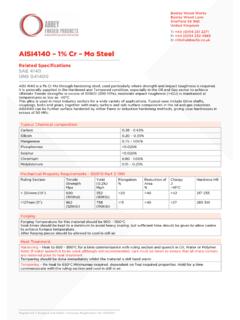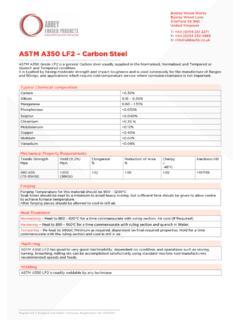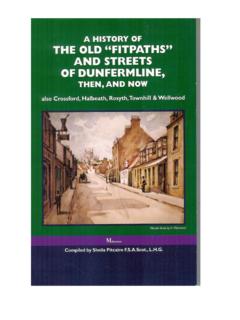Transcription of The construction of medieval “style” arrows
1 1 The construction of medieval style arrowsBy Karsten von Meissen (mka Karsten Shein)As in the medieval world, archery in theSCA is commonplace. However, the limitedtime and money of many SCA participantsleads them to purchase archery equipmentthat may not be as authentically medieval as they would like. It is therefore thepurpose of this paper to provide somebackground on what constitutes a medieval (circa 650 1650 AD) European arrow andhow arrows of sturdy construction can bemade by almost anyone for around the costof a set of ready-made modern 1 - The medieval arrowWhat did it look like? What was it made of?How big was it? These are not the easiest ofquestions to answer as there are no completesurviving medieval arrows . This is becausearrows were made from lightweight, porouswoods that would deteriorate rapidly whenexposed to the environment.
2 Of the fewexamples that survive, the Mary Rosearrows have only the shaft and a few Westminster arrow (ca. 1440s) containsonly the point and glue fragments. Thereare, however hundreds of depictions ofarchers shooting arrows , from the 8thCentury up to the 17th (see figs 1-5). Thesearrows by and large appear to be of a fairlyuniform composition. They are all under ayard long (given by the average draw lengthof a typical archer of the day) and have threefeathers fletched to the base of the shape of the fletching varies but doesfall into three primary shapes, delta, shield,and parabolic. The arrow was fit to thebowstring by means of a nock, or groove,cut into the base of the arrow . The points,many of which do survive, vary widelybased, it is assumed, on their arrowheads are the most commonlysurviving pieces of medieval arrows (tens ofthousands were shot in the course of singlebattles), we ll examine them first.
3 The mostcommonly found point is the bodkin point(figs 6 & 7). A simple needle-shaped pointthat could penetrate most anything themedieval world had to offer. 2001 K. SheinFigure 1. Lid of an 8th C. Franks' casket in the British Museum (note the barbedbroadheads and fletching design).2 Figure 2. Archers in the Bayeux Tapestry(note the similarity of arrows to those in fig1).Figure 3. Archer in the 14th C. LutrellPsalter. The arrows have parabolic fletchingand target points. British MuseumFigure 4. Detailed depiction of a war arrowfrom Sippe's Sebastian's Altar (WallrafRicharz Museum, Koln).Figure 5. Soldier from the Double ArmedMan, circa 6 & 7. A variety of medieval arrowheads from the Museum of London. The mostcommon type depicted is the narrow broadhead (fig. 7) types 13 & 16, but the mostcommonly found is (fig 7) type 8 (bodkin point). The Mary Rose arrows had type 16 common alternative was the broad broad head could be leaf-shaped orbarbed (fig 6 & 7).
4 Barbs on arrowheadsnormally were rather short and could flareout or flare back, but could sometimes beforged out to several inches in length in a swallow-tail design. In addition, there aresome more oddly shaped types that begexplanation. These include blunts, flat orbulbous shaped heads used primarily fortarget practice, small game or pelt hunting,and large crescent-shaped heads that expertstheorize may have been intended for cuttingships rigging (but may also have been usedto great effect in land battles). In general,points are not overly large. They tend to bebetween two and three inches total length,including the socket or tang. Mostarrowheads used in England were of thesocketed type, while arrowheads found onthe continent are equally divided betweentanged and socketed. Points, on averageweighed around 14 grams (Hardy, 1992).
5 Although several medieval arrow shaftssurvive, we know relatively little aboutthem. Most of what is known is derivedfrom a few historical records and moderninference. In 1545 Roger Ascham wrotethat the preferred wood for shafts was asp or aspen, but this most likely refers to any ofthe poplar species such as willow (Ascham,1545). These trees grow quickly and caneasily provide for the huge quantities ofarrows. medieval sources, Ascham includedalso refer to ash arrows , and, Ascham addsthey are preferred to asp shafts for war being both swifter and heavier. The shaftfound in Henry V s Chantry Chapel inWestminster Abbey is most likely made outof ash, but the Mary Rose shafts are also inpoplar (Hardy, 1992). Thus it is likely thatwhen large arrow contracts were filled, anyacceptable wood would do, because the ideabehind the shaft was to deliver an arrowheadto the target without expecting it to berecovered.
6 Other woods that Ascham notesas being good for shafts include brazil,birch, oak, beech and shaft was more or less a dowel, about aninch and a half beyond the drawlength of thearcher. For mass produced arrows , such asthose from the Mary Rose, it appearsstandard draw lengths of 28 and 30 incheswere used (shafts and inches).The diameter of most, judging by the headsis between 1/2 inch and 3/8ths of an shafts recovered from the Mary Rosewere estimated to have weights between 35and 60 grams (suitable for bows from 70 toaround 140 pounds respectively). Theweight of the Westminster arrow wasestimated to be roughly 35 grams (Hardy,1992). The lighter weight shafts, notsurprisingly, had smaller heads. Unlikemost modern shafts, the most efficient shapeof a war arrow was slightly tapered frompoint to nock.
7 The Mary Rose arrows areboth tapered (about 1/2 inch diam. at the tipto 3/8 inch at the nock) and parallel(Bartlett, 1999). The Westminster arrowtapers from inches diameter to at the nock. It is presumed that thetaper would allow greater penetration due tothe wide end entering the target first(Bartlett, 1999). In addition, the extra massnear the front of the arrow should helpstabilize the arrow in flight and provideslightly greater energy transfer to the , tapered arrows are moreexpensive to make, and so it is not unlikelythat many medieval livery arrows wereparallel nock is the notch at the base of thearrow shaft into which the bow string ispositioned. medieval images as well assurviving shafts all show the nock groovecut directly into the arrow . In many casesextra wood was left around the end of theshaft to support the energy transfer from the5string to the arrow (fig 3).
8 In otherinstances, such as the Mary Rose arrows , aslit was made parallel to the grain and a twoinch sliver of horn or bone was inserted(about 1/16 thick). The nock was then cutperpendicular to the insert about 1/4 deepand 1/8 wide (Bartlett, 1999).Alternatively, a hardwood dowel could bespliced to the base of the shaft and the nockcut into the harder wood. Because of therelative complexity of this method, it wouldprobably have been reserved for moreexpensive target , the fletching. The fletching on thearrow is what, ultimately, makes an arrowlook medieval (or not). Fletches were madeof feathers (though it has been noted thatparchment from looted books had been usedto repair arrows in the field). The preferredfeather was from the common (gray) goose,though in practice, the wing feathers fromany larger bird would suffice.
9 Moreexpensive arrows often sported fletchingfrom swan or peacock feathers. The featherswould be cut to shape prior to attachingthem to the shaft. The predominant designof medieval fletching was a pointedtriangular shape (fig. 4). This shape is theeasiest for the fletcher to trim and hence arepreferred when a large number of arrowsmust be produced. Parabolic shapedfletching is also seen in many contemporaryillustrations as are delta or shield shapes(fig. 3). The fletching imprints left onsurviving shafts are about 6 inches in length,but by measuring the length of arrows inillustrations and assuming a length of 30inches, we can derive a fletch lengthanywhere between 5 and 10 inches. Again,using relative lengths, we can deduce theheight of the fletching to be between oneand three inches.
10 Once the feathers had beentrimmed to shape, they would be alignedwith the nock and glued on with a 120degree spacing between fletches. Becausethe glue was not waterproof, it wasgenerally necessary to wind fine silk or linenthread through the fletching to keep it tightlyadhered to the shaft, about 5 turns per inch isdocumented. More glue would then havebeen spread over the thread. In westernEurope, fletching would have been appliedat least two inches from the nock to allowfor finger room. Eastern European archers,who shot with a thumb ring, would requireonly about an inch of room. No medievalfletchings survive, but illustrations show thatthey often were fully or partially colored(Hardy, 1992). The Hours of Catherine ofCleves (ca. 1440; Pierpont Morgan Library)shows red and blue fletching. Most likelyan off color fletch was used for the nock feather (the one perpendicular to the nockorientation) to aid the archer in quicklyidentifying the correct orientation of thearrow on the string.



